HONDA CIVIC COUPE 2015 9.G Owner's Manual
Manufacturer: HONDA, Model Year: 2015, Model line: CIVIC COUPE, Model: HONDA CIVIC COUPE 2015 9.GPages: 441, PDF Size: 18.4 MB
Page 21 of 441
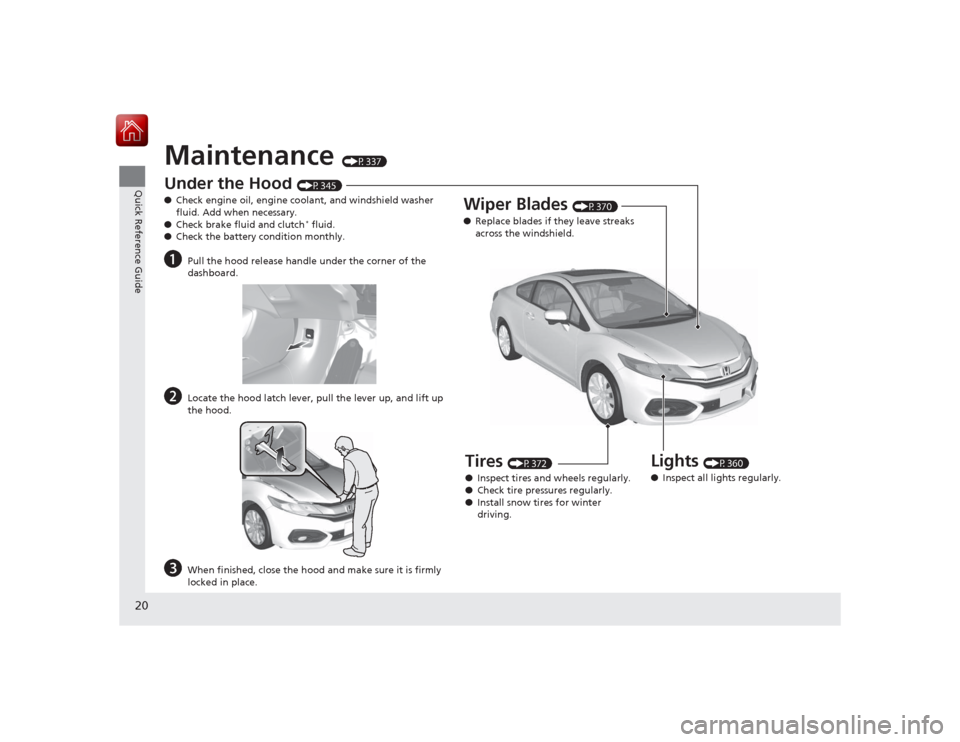
20Quick Reference Guide
Maintenance
(P337)
Under the Hood
(P345)
● Check engine oil, engine coolant, and windshield washer
fluid. Add when necessary.
● Check brake fluid and clutch* fluid.
● Check the battery condition monthly.
a
Pull the hood release handle under the corner of the
dashboard.
b
Locate the hood latch lever, pull the lever up, and lift up
the hood.
c
When finished, close the hood and make sure it is firmly
locked in place.
Lights
(P360)
● Inspect all lights regularly.
Wiper Blades
(P370)
● Replace blades if they leave streaks
across the windshield.
Tires
(P372)
● Inspect tires and wheels regularly.
● Check tire pressures regularly.
● Install snow tires for winter
driving.
Page 22 of 441
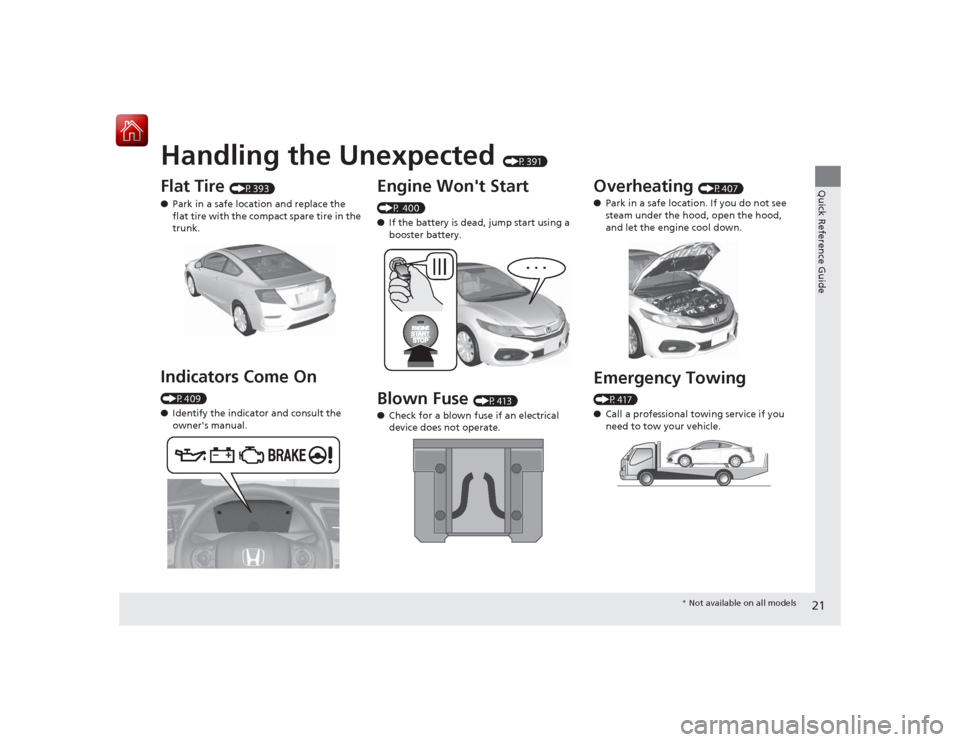
Quick Reference Guide21
Handling the Unexpected
(P391)
Flat Tire
(P393)
● Park in a safe location and replace the
flat tire with the compact spare tire in the
trunk.
Indicators Come On (P409)
●Identify the indicator and consult the
owner's manual.
Engine Won't Start (P 400)
●If the battery is dead, jump start using a
booster battery.Blown Fuse
(P413)
● Check for a blown fuse if an electrical
device does not operate.
Overheating
(P407)
● Park in a safe location. If you do not see
steam under the hood, open the hood,
and let the engine cool down.
Emergency Towing (P417)
●Call a professional towing service if you
need to tow your vehicle.
* Not available on all models
Page 23 of 441
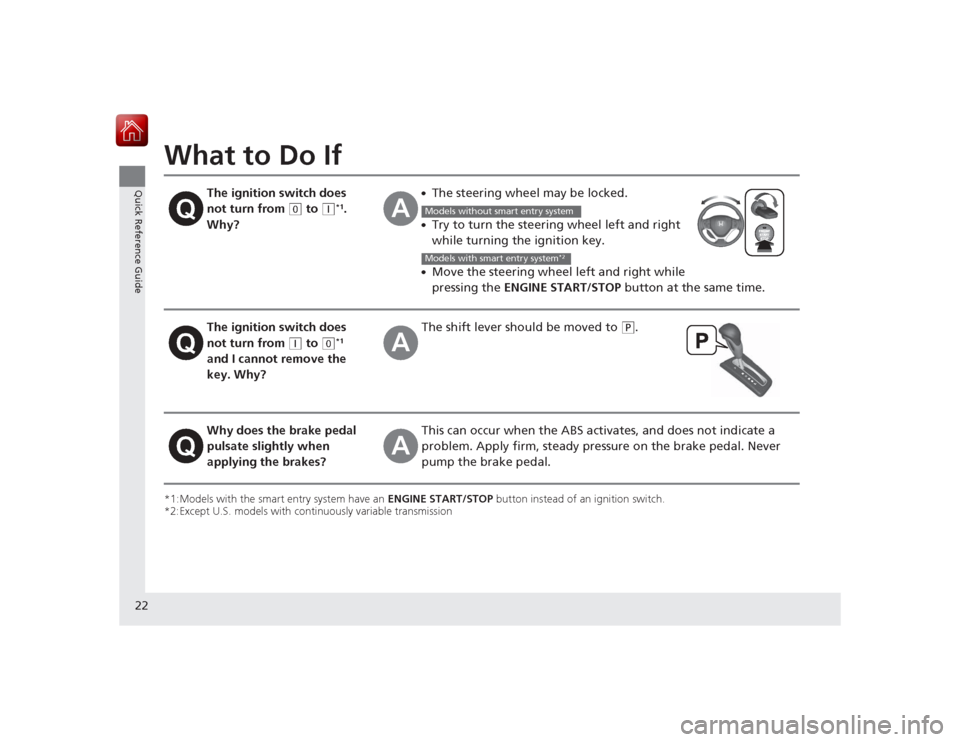
22Quick Reference Guide
What to Do If*1:Models with the smart entry system have an ENGINE START/STOP button instead of an ignition switch.
*2:Except U.S. models with continuously variable transmission
The ignition switch does
not turn from
(0
to
(q
*1.
Why?
●The steering wheel may be locked.●Try to turn the steering wheel left and right
while turning the ignition key.●Move the steering wheel left and right while
pressing the ENGINE START/STOP button at the same time.
The ignition switch does
not turn from
(q
to
(0
*1
and I cannot remove the
key. Why?
The shift lever s hould be moved to
(P
.
Why does the brake pedal
pulsate slightly when
applying the brakes?
This can occur when the ABS act ivates, and does not indicate a
problem. Apply firm, steady pressure on the brake pedal. Never
pump the brake pedal.Models without smart entry systemModels with smart entry system
*2
Page 24 of 441
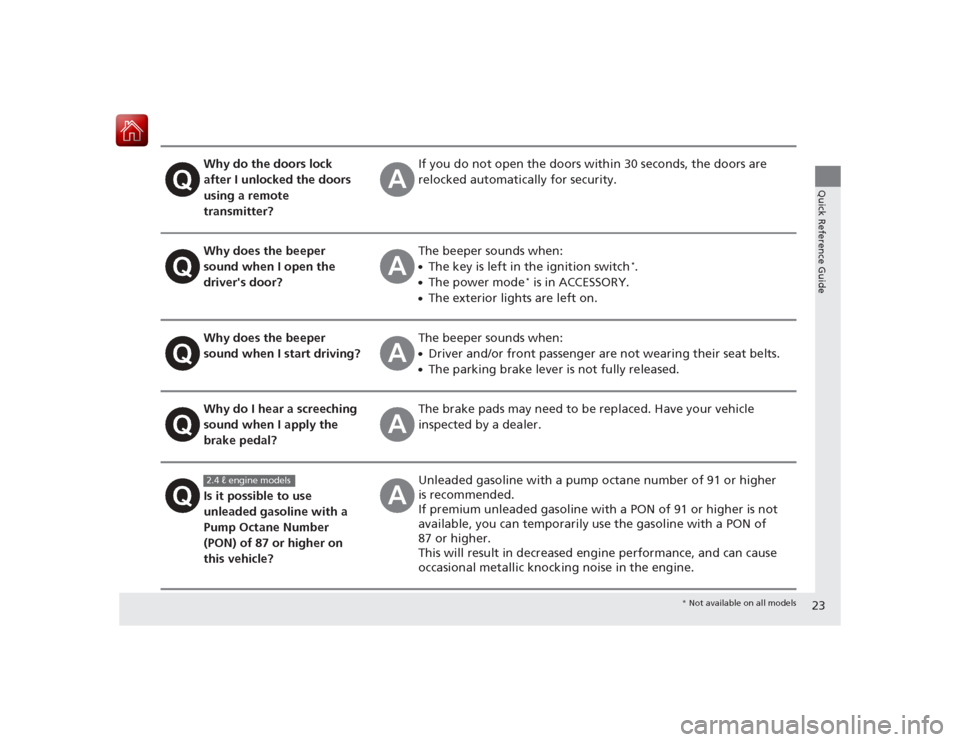
23Quick Reference Guide
Why do the doors lock
after I unlocked the doors
using a remote
transmitter?
If you do not open the doors within 30 seconds, the doors are
relocked automatically for security.
Why does the beeper
sound when I open the
driver's door?
The beeper sounds when:●The key is left in the ignition switch
*.
●The power mode
* is in ACCESSORY.
●The exterior lights are left on.
Why does the beeper
sound when I start driving?
The beeper sounds when:●Driver and/or front passenger are not wearing their seat belts.●The parking brake lever is not fully released.
Why do I hear a screeching
sound when I apply the
brake pedal?
The brake pads may need to be replaced. Have your vehicle
inspected by a dealer.
Is it possible to use
unleaded gasoline with a
Pump Octane Number
(PON) of 87 or higher on
this vehicle?
Unleaded gasoline with a pump octane number of 91 or higher
is recommended.
If premium unleaded gasoline with a PON of 91 or higher is not
available, you can temporarily use the gasoline with a PON of
87 or higher.
This will result in decreased engine performance, and can cause
occasional metallic knocking noise in the engine.
2.4 ℓ engine models
* Not available on all models
Page 25 of 441

24
Page 26 of 441
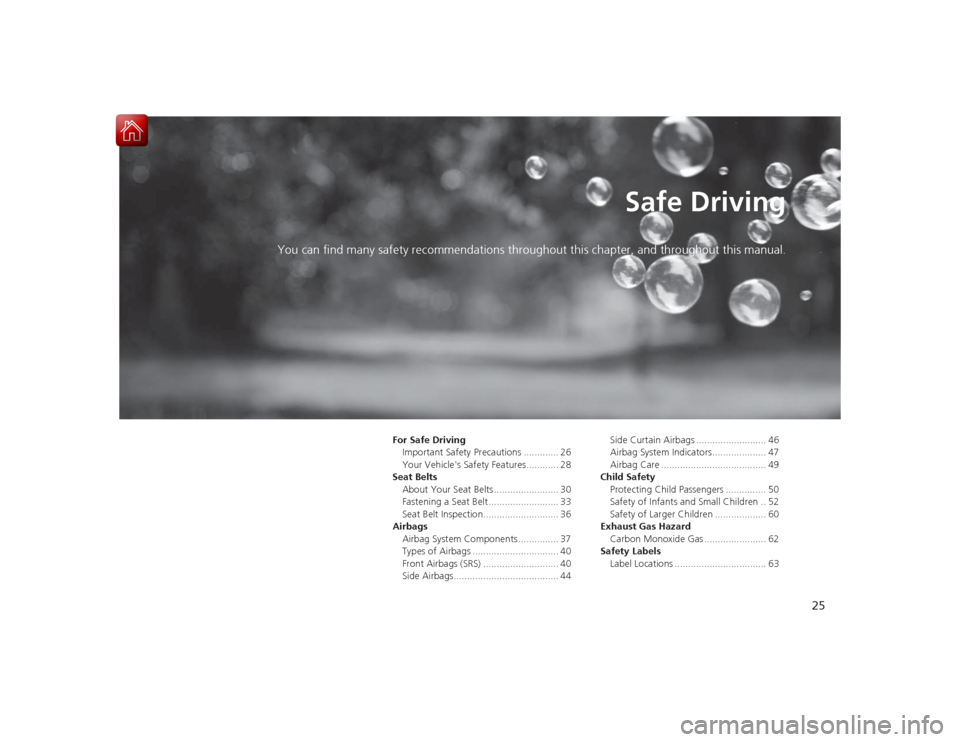
25
Safe Driving
You can find many safety recommendations throughout this chapter, and throughout this manual.
For Safe DrivingImportant Safety Precautions ............. 26
Your Vehicle's Safety Features............ 28
Seat Belts About Your Seat Belts ........................ 30
Fastening a Seat Belt .......................... 33
Seat Belt Inspection............................ 36
Airbags Airbag System Components ............... 37
Types of Airbags ................................ 40
Front Airbags (SRS) ............................ 40
Side Airbags....................................... 44 Side Curtain Airbags .......................... 46
Airbag System Indicators.................... 47
Airbag Care ....................................... 49
Child Safety Protecting Child Passengers ............... 50
Safety of Infants and Small Children .. 52
Safety of Larger Children ................... 60
Exhaust Gas Hazard Carbon Monoxide Gas ....................... 62
Safety Labels Label Locations .................................. 63
Page 27 of 441
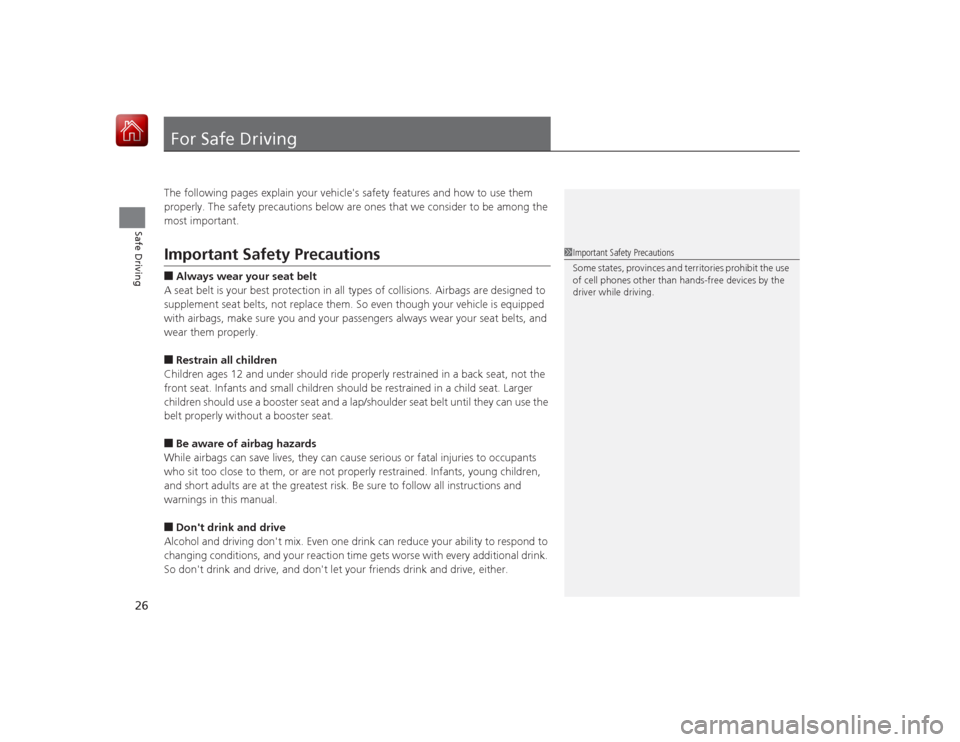
26Safe Driving
For Safe DrivingThe following pages explain your vehicle's safety features and how to use them
properly. The safety precautions below are ones that we consider to be among the
most important.Important Safety Precautions■Always wear your seat belt
A seat belt is your best protection in all types of collisions. Airbags are designed to
supplement seat belts, not replace them. So even though your vehicle is equipped
with airbags, make sure you and your passengers always wear your seat belts, and
wear them properly.■Restrain all children
Children ages 12 and under should ride properly restrained in a back seat, not the
front seat. Infants and small children should be restrained in a child seat. Larger
children should use a booster seat and a lap/shoulder seat belt until they can use the
belt properly without a booster seat.■Be aware of airbag hazards
While airbags can save lives, they can cause serious or fatal injuries to occupants
who sit too close to them, or are not properly restrained. Infants, young children,
and short adults are at the greatest risk. Be sure to follow all instructions and
warnings in this manual.■Don't drink and drive
Alcohol and driving don't mix. Even one drin k can reduce your ability to respond to
changing conditions, and your reaction time gets worse with every additional drink.
So don't drink and drive, and don't let your friends drink and drive, either.
1 Important Safety Precautions
Some states, provinces and territories prohibit the use
of cell phones other than hands-free devices by the
driver while driving.
Page 28 of 441
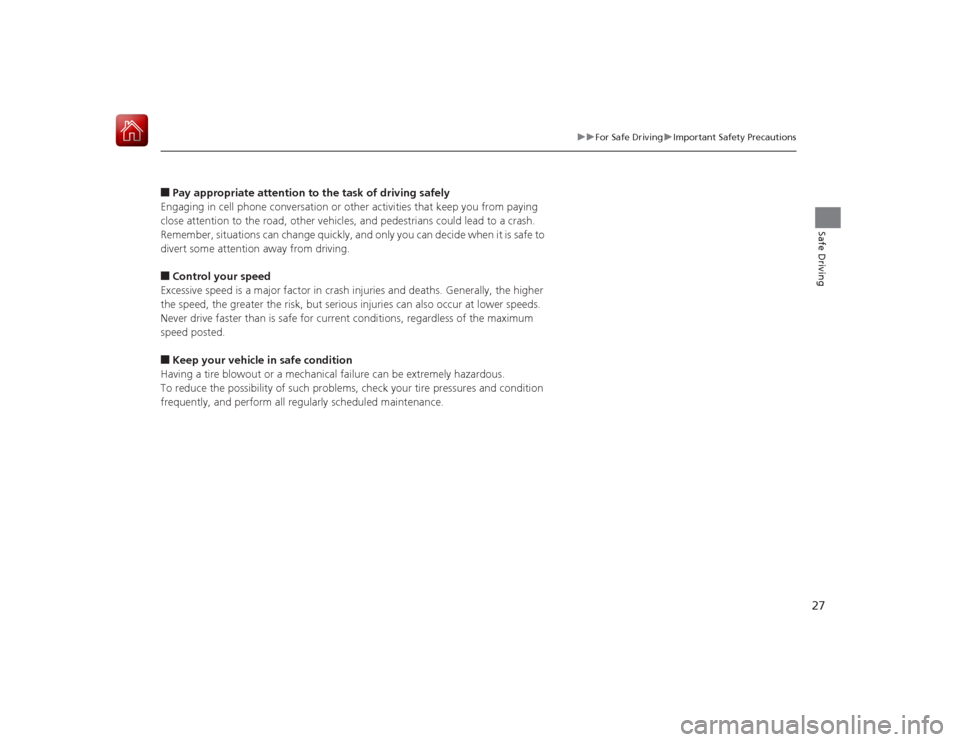
27
uuFor Safe Driving uImportant Safety Precautions
Safe Driving
■Pay appropriate attention to the task of driving safely
Engaging in cell phone conversation or other activities that keep you from paying
close attention to the road, other vehicles, and pedestrians could lead to a crash.
Remember, situations can change quickly, and only you can decide when it is safe to
divert some attention away from driving.■Control your speed
Excessive speed is a major factor in crash injuries and deaths. Generally, the higher
the speed, the greater the risk, but serious injuries can also occur at lower speeds.
Never drive faster than is safe for current conditions, regardless of the maximum
speed posted.■Keep your vehicle in safe condition
Having a tire blowout or a mechanical failure can be extremely hazardous.
To reduce the possibility of such problems, check your tire pressures and condition
frequently, and perform all regularly scheduled maintenance.
Page 29 of 441
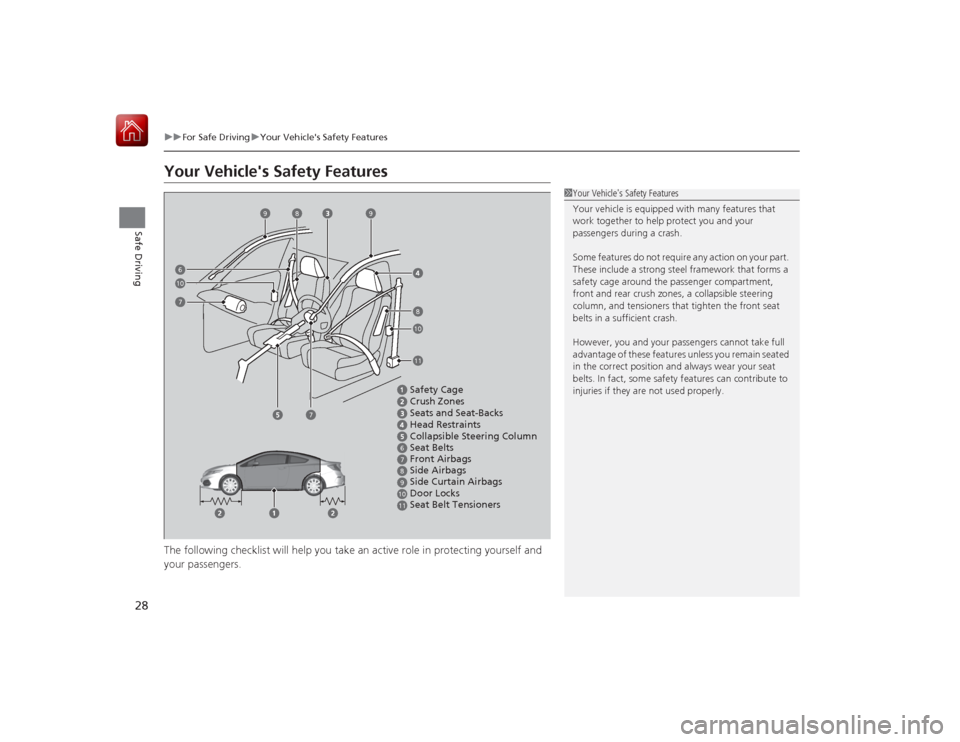
28
uuFor Safe Driving uYour Vehicle's Safety Features
Safe Driving
Your Vehicle's Safety FeaturesThe following checklist will help you take an active role in protecting yourself and
your passengers.
1Your Vehicle's Safety Features
Your vehicle is equipped with many features that
work together to help protect you and your
passengers during a crash.
Some features do not require any action on your part.
These include a strong steel framework that forms a
safety cage around the passenger compartment,
front and rear crush zones, a co llapsible steering
column, and tensioners that tighten the front seat
belts in a sufficient crash.
However, you and your passengers cannot take full
advantage of these features unless you remain seated
in the correct position and always wear your seat
belts. In fact, some safety features can contribute to
injuries if they are not used properly.
67891011Safety Cage
Crush Zones
Seats and Seat-Backs
Head Restraints
Collapsible Steering Column
Seat Belts
Front Airbags
Side Curtain Airbags
Door Locks Side Airbags
Seat Belt Tensioners
6
7
8
1011
9
9
8
710
Page 30 of 441
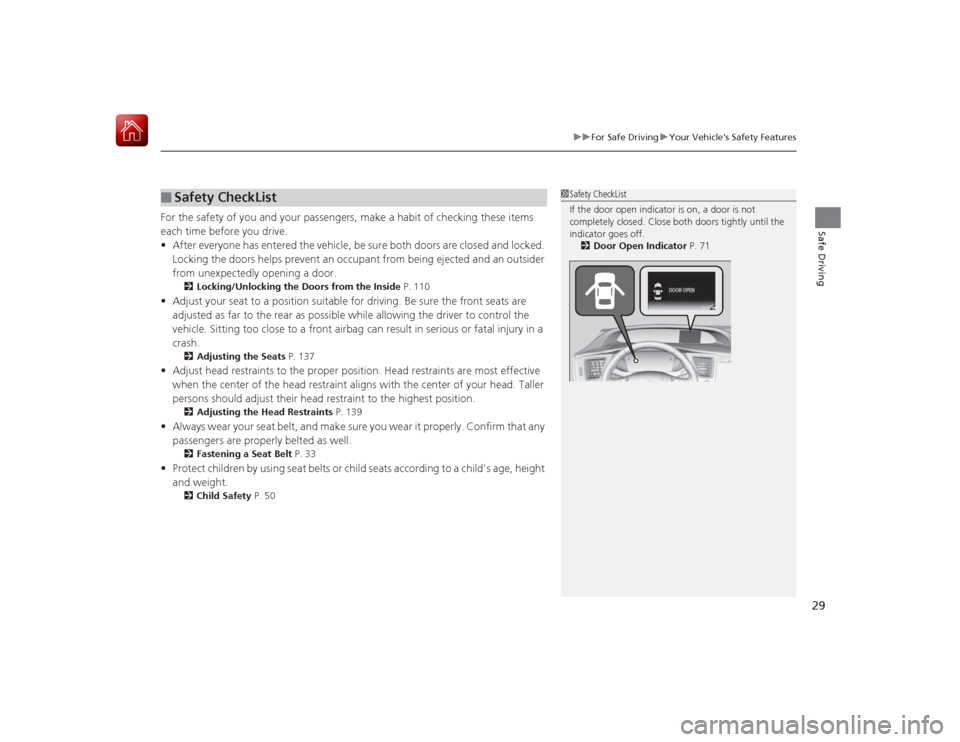
29
uuFor Safe Driving uYour Vehicle's Safety Features
Safe Driving
For the safety of you and your passengers, make a habit of checking these items
each time before you drive.
• After everyone has entered the vehicle, be sure both doors are closed and locked.
Locking the doors helps prevent an occupant from being ejected and an outsider
from unexpectedly opening a door.
2 Locking/Unlocking the Doors from the Inside P. 110
•Adjust your seat to a position suitable for driving. Be sure the front seats are
adjusted as far to the rear as possible while allowing the driver to control the
vehicle. Sitting too close to a front airbag can result in serious or fatal injury in a
crash.
2 Adjusting the Seats P. 137
•Adjust head restraints to the proper position. Head restraints are most effective
when the center of the head restraint aligns with the center of your head. Taller
persons should adjust their head restraint to the highest position.
2 Adjusting the Head Restraints P. 139
•Always wear your seat belt, and make sure you wear it properly. Confirm that any
passengers are properly belted as well.
2 Fastening a Seat Belt P. 33
•Protect children by using seat belts or child seats according to a child's age, height
and weight.
2 Child Safety P. 50
■
Safety CheckList
1Safety CheckList
If the door open indicator is on, a door is not
completely closed. Close both doors tightly until the
indicator goes off.
2 Door Open Indicator P. 71